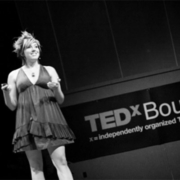Our Favorite Things Volume 14: Materials Mashup
by Maggie Flickinger
This time of year, everything can start taking on a wash of, well, dreariness…boredom…familiarity. It’s the February doldrums in full effect! Not that familiarity is bad, but things can be a lot more fun with a dash of the unexpected. Some of Our Favorite Things surprise us with Materials Mashups. Familiar forms reinvented with unexpected materials, materials applications that inspire a rethinking of function, new production techniques for ancient building systems – here are a few of our Materials Mashup must-haves…
 Back in the day – by which we mean the 1920’s – the popular petticoat shade was demurely crafted of delicate milk glass. Then along came feminism and a dash of steampunk…the creative minds at NativeCast reimagined the petticoat form with a stronger, more rough and tumble concrete shade. Their Milkglass Pendant doesn’t throw the baby out with the bathwater, keeping the throwback filament bulb and solid brass fittings typical of this vintage style. The juxtaposition of the coy ruffled form crafted of unexpectedly heavy concrete is quintessential material mashup.
Back in the day – by which we mean the 1920’s – the popular petticoat shade was demurely crafted of delicate milk glass. Then along came feminism and a dash of steampunk…the creative minds at NativeCast reimagined the petticoat form with a stronger, more rough and tumble concrete shade. Their Milkglass Pendant doesn’t throw the baby out with the bathwater, keeping the throwback filament bulb and solid brass fittings typical of this vintage style. The juxtaposition of the coy ruffled form crafted of unexpectedly heavy concrete is quintessential material mashup.
 How about replacing the materials of gasoline, glass, metal, and combustion with the clean energy of our own two feet? That’s the idea of the Walking School Bus. The “bus driver” still takes part – but as a “bus walker,” acting as an adult chaperone to keep kids safe and on track…often there is a front bus walker and a rear bus walker. While not a new concept, it’s gaining traction in the US partially thanks to a nod from Michelle Obama in a July 2013 speech: outside of the environmental benefits, she touts the added bonus of pushing back the alarming childhood obesity trend.
How about replacing the materials of gasoline, glass, metal, and combustion with the clean energy of our own two feet? That’s the idea of the Walking School Bus. The “bus driver” still takes part – but as a “bus walker,” acting as an adult chaperone to keep kids safe and on track…often there is a front bus walker and a rear bus walker. While not a new concept, it’s gaining traction in the US partially thanks to a nod from Michelle Obama in a July 2013 speech: outside of the environmental benefits, she touts the added bonus of pushing back the alarming childhood obesity trend.
 Since Neolithic times, earth has been employed as a functional, spirit-of-place building system. In recent years, the comparative cost of rammed earth has skyrocketed when pitched against commercially available, mass produced building systems like the stick frame and the ubiquitous CMU. On-site block building machines can help, but structural integrity and specialized construction techniques can be problematic. Now, Watershed Block has commercialized the production of rammed earth blocks, clocking in at just 15-20% pricier than a colored ground face CMU. While we have concerns about insulating exterior applications in our mountain climate, this seems like a great contender for internal mass walls in passive solar homes. Only in CA for now, they’re currently on the lookout for suitable mico-manufacturing sites nationwide.
Since Neolithic times, earth has been employed as a functional, spirit-of-place building system. In recent years, the comparative cost of rammed earth has skyrocketed when pitched against commercially available, mass produced building systems like the stick frame and the ubiquitous CMU. On-site block building machines can help, but structural integrity and specialized construction techniques can be problematic. Now, Watershed Block has commercialized the production of rammed earth blocks, clocking in at just 15-20% pricier than a colored ground face CMU. While we have concerns about insulating exterior applications in our mountain climate, this seems like a great contender for internal mass walls in passive solar homes. Only in CA for now, they’re currently on the lookout for suitable mico-manufacturing sites nationwide.
 Ecovative has been pioneering sustainable packaging and insulation grown from Mycelium – the vegetative part of fungus – for a few years, and is now expanding into architectural & structural possibilities. David Benjamin’s seasonal Hy-Fi folly for MOMA/P.S.1 will grow building blocks out of mycelium and corn husks within a reflective framework designed to maximize the growth by increasing solar delivery. Mycelium is also the basis of mycoprotein – found in the popular Quorn brand vegetarian food – so I wonder how far off we are from an organic, renewable, edible structure…the mushroom revolution is here!
Ecovative has been pioneering sustainable packaging and insulation grown from Mycelium – the vegetative part of fungus – for a few years, and is now expanding into architectural & structural possibilities. David Benjamin’s seasonal Hy-Fi folly for MOMA/P.S.1 will grow building blocks out of mycelium and corn husks within a reflective framework designed to maximize the growth by increasing solar delivery. Mycelium is also the basis of mycoprotein – found in the popular Quorn brand vegetarian food – so I wonder how far off we are from an organic, renewable, edible structure…the mushroom revolution is here!





















Leave a Reply
Want to join the discussion?Feel free to contribute!